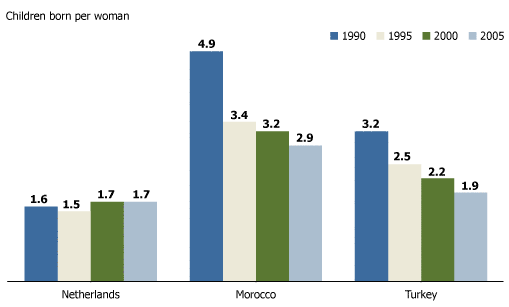Mary Kent
Consultant

Extremely low birth rates in most of Europe have fueled concerns about population decline, yet one segment of the continent’s population—Muslims—continues to grow. The increasing number and visibility of Muslims in Western Europe, juxtaposed with the low fertility among non-Muslims, has led some Europeans to worry that the region will eventually have a Muslim majority, fundamentally changing Western European society. A new study by demographers Charles Westoff and Tomas Frejka challenges this common perception and suggests that the fertility gap between Muslims and non-Muslims is shrinking.
Concerns about the rapid growth of Muslims are based on popular perceptions, not statistical evidence. Because many European countries do not ask a person’s religion on official forms or in censuses, it has been difficult to obtain accurate estimates of the number or childbearing rates of Muslims. Nevertheless, it seems clear that Muslims are far from achieving majority status. Muslims make up less than 5 percent of the population in most European countries. France has the largest Muslim population in Western Europe. An estimated 4 million to 6 million Muslims make up between 6 percent and 10 percent of the French population.
There are long-standing Muslim communities in some Eastern and Central European countries, especially in the Balkans, but only in Albania do Muslims constitute a large majority. Russia’s Muslim population is huge, at least 15 million strong, yet makes up less than 15 percent of the total. Unlike the Western European Muslims, who are part of a large immigration wave that began after World War II, virtually all Eastern European Muslims are native-born.
In their study, Westoff and Frejka sift through the available data to estimate the level and trends in childbearing among European Muslims. They show that although Muslim immigrants do have more children than other Europeans, their fertility tends to decline over time, often faster than among non-Muslims.
In Austria, for example, Muslim women had a total fertility rate (an estimate of lifetime births per woman) of 3.1 children per woman in 1981, well above the 1.7 average for the majority Roman Catholic women. By 2001, the rate for Catholics had fallen to 1.3, but the Muslim rate had fallen to 2.3—leaving a difference of just one child per woman between Muslims and non-Muslims.
The gap narrowed even further in the former West Germany, where the authors relied on data by mother’s nationality rather than religion. West Germany recruited a large number of workers from Turkey beginning in the 1960s, giving Germany one of Western Europe’s largest Muslim populations. In 1970, Turkish women living in West Germany had more than two more children than German women. By 1996, the difference between these two groups had fallen to one child.
Recent trends in the Netherlands tell a similar story (see figure). The fertility gap between native-born women and women born in predominantly Muslim Morocco and Turkey narrowed considerably between 1990 and 2005.
Fertility Decline in the Netherlands Among Women Born in the Netherlands, Morocco, and Turkey, 1990 to 2005

Source: Statistics Netherlands, 2006, as cited in C.F. Westoff and T. Frejka, Population and Development Review 33, no. 4 (2007): table 3.
Fertility levels in the countries of origin for Muslim immigrants are reflected in different fertility rates among Muslim groups in Europe, as immigrants often arrive with the norms of their home countries. In Norway, the TFRs varied substantially depending on where women were born. Among immigrant women living in Norway, Somali women had a TFR of 5.2 in 1997-1998, compared with 4.8 for Iraqis, 3.1 for Turks, and 1.9 for Iranians. Native Norwegian women had 1.8 children on average during the period.
But fertility has been falling in many Muslim countries in the Middle East and Africa, which may help explain why younger Muslim women have lower fertility than older women. In Turkey, the TFR dropped from 3.3 in the 1985 to 1990 period to about 2.2 in 2003. Over the same span of years, the TFR fell from 4.5 to 2.5 in Morocco, and from 5.6 to 2.1 in Iran, according to UN estimates.
Muslims who grew up in Europe in immigrant families are also likely to adopt the majority population’s preference for smaller families. All countries in Europe have had low fertility for decades.
Westoff and Frejka also explored how religiousness may be linked to higher fertility. Women who report firm adherence to their religious beliefs and practices tend to have higher fertility than less religious women, whether Christian or Muslim. But religiousness does not always mean higher fertility. As the authors point out, Islam does not prohibit family planning, so women can have small families and follow their Islamic faith. The dramatic decline in Iran’s fertility provides a recent example of how strict Islamic practices can coexist with widespread use of family planning.
Other factors also contribute to the higher Muslim fertility, including younger marriage ages for Muslims and a tendency to have children soon after immigrating. If Muslim immigrants have fewer children as they adapt to their host community, the eventual gap may not be as large as the most recent data suggest.
The study confirms the perception that Muslim women have more children than non-Muslims in Western Europe, but shows that the gap is not as large as many believe. And, similar to other immigrants in other countries, Muslim fertility rates tend to fall over time, narrowing the gap with the non-Muslims who make up the vast majority of the European population now, and for the foreseeable future.
Reference
Charles F. Westoff and Tomas Frejka, “Religiousness and Fertility Among European Muslims,” Population and Development Review 33, no. 4 (2007): 785-809.
